| Admissions | Aircraft | Aviation World | Ambassadors | Accreditation | A to Z Degree Fields | Books | Catalog | Colleges | Contact Us | Continents/States | Construction | Contracts | Distance Education | Emergency | Emergency Medicine | Examinations | English Editing Service | Economy and budget | Forms | Faculty | Governor | Grants | Hostels | Honorary Doctorate degree | Human Services | Human Resources | Internet | Investment | Instructors | Internship | Login | Lecture | Librarians | Languages | Manufacturing | Membership | Observers | Public Health | Publication | Professional Examinations | Programs | Professions | Progress Report | Recommendations | Ration food and supplies | Research Grants | Researchers | Students login | School | Search | Software | Seminar | Study Center/Centre | Sponsorship | Tutoring | Thesis | Universities | Work counseling |
|
From day to day do you find yourself using any of the six simple machines: Wedge Lever Incline Plane Pulley Wheel Screw Simple Machines: These devices were all in common use for centuries before Leonardo's time. Each one makes work easier to do by providing some trade-off between the force applied and the distance over which the force is applied. 
Wheel and Axle In this machine a wheel or spoke is locked to a central axle so that when one is turned the other must turn. A longer motion at the edge of the wheel is converted to a shorter more powerful motion at the axle. In reverse, a short powerful force at the axle will move the wheel's edge a greater distance. 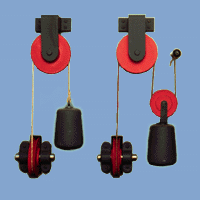
Pulley System A single pulley simply reverses the direction of a force. When two or more pulleys are connected together, they permit a heavy load to be lifted with less force. The trade-off is that the end of the rope must move a greater distance than the load. 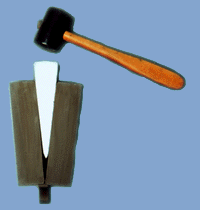
Wedge A wedge converts motion in one direction into a splitting motion that acts at right angles to the blade. Nearly all cutting machines use the wedge. A lifting machine may use a wedge to get under a load. 
Screw A screw is a central core with a thread or groove wrapped around it to form a helix. While turning, a screw converts a rotary motion into a forward or backward motion.  Lever
LeverA lever is a stiff rod that rotates around a pivot point. Downward motion at one end results in upward motion at the other end. Depending on where the pivot point is located, a lever can multiply either the force applied or the distance over which the force is applied. Other Elements of Machines: Though these devices were also used in machines in Leonardo's time, he experimented with them and made changes to improve how they worked. He also combined them in many exciting new ways to create machines and inventions that had never been seen before. 
Gears Gears are toothed or pegged wheels meshed together to transmit motion and force. In any pair of gears the larger one will rotate more slowly than the smaller one, but will rotate with greater force. Each gear in a series reverses the direction of rotation of the previous gear. 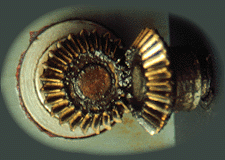
Bevel Gears Gears that mesh at an angle change the direction of rotation. 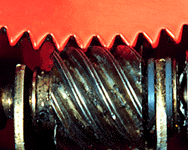
Worm Gear A worm gear is a combination of a gear meshed with the threads of a screw. This combination changes the direction of turning motion by ninety degrees. Worm gears also decrease the speed of turning from screw to gear and increase its force. 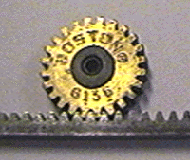
Rack and Pinion A single gear, the pinion, meshes with a sliding toothed rack. This combination converts rotary motion to back and forth motion. Windshield wipers in cars are powered by a rack and pinion mechanism. A small pinion at the base of the wiper meshes with a sliding rack below. 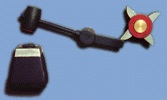
Cam A cam is a wheel with shaped bumps on it. Cams are often connected to rods, levers, or springs. In the gravity trip hammer shown here, the bumps on the turning cam push down on the end of the lever making it raise the hammer again and again. 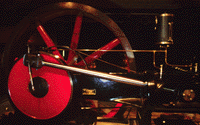
Crank and Rod The crank is a wheel with a pivoting arm attached near its edge. The arm is attached by a hinge to a rod. When the crank turns, the rod is pushed back and forth. Alternatively, if the rod is pushed back and forth at the right speed, the crank will turn. The crank and rod shown here are part of giant steam engine. 
Chains and Belts A chain or belt connects two separated wheels so that one turns, the other will turn in the same direction. 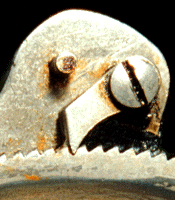
Ratchet A ratchet is a device that allows a wheel to turn in only one direction. The ratchet wheel has specially shaped teeth. A bar on a pivot called the "pawl" is fixed above the ratchet wheel. The pawl slides over the teeth of the ratchet in one direction, but blocks the motion of the teeth if the wheel turns in the other direction. |
